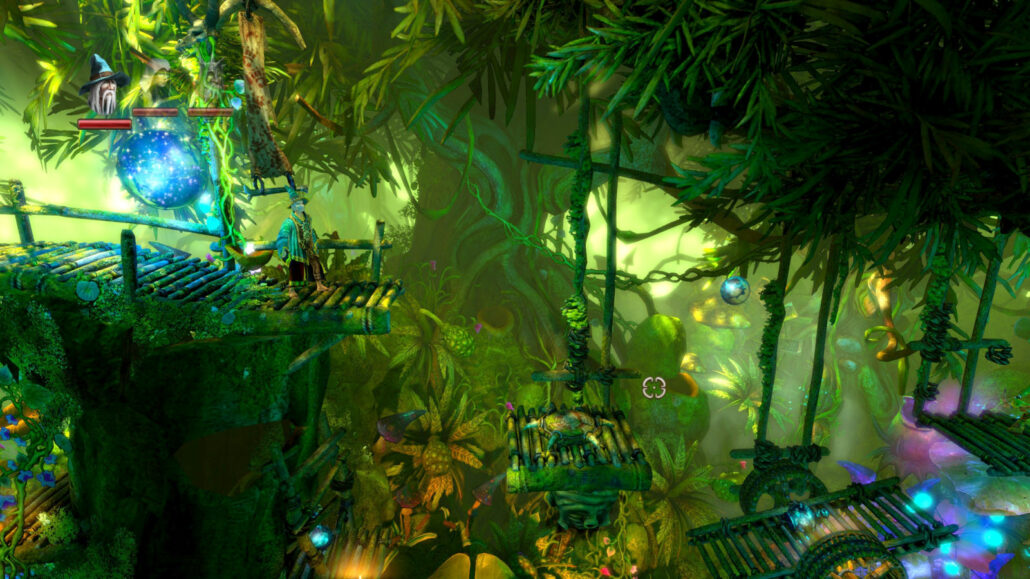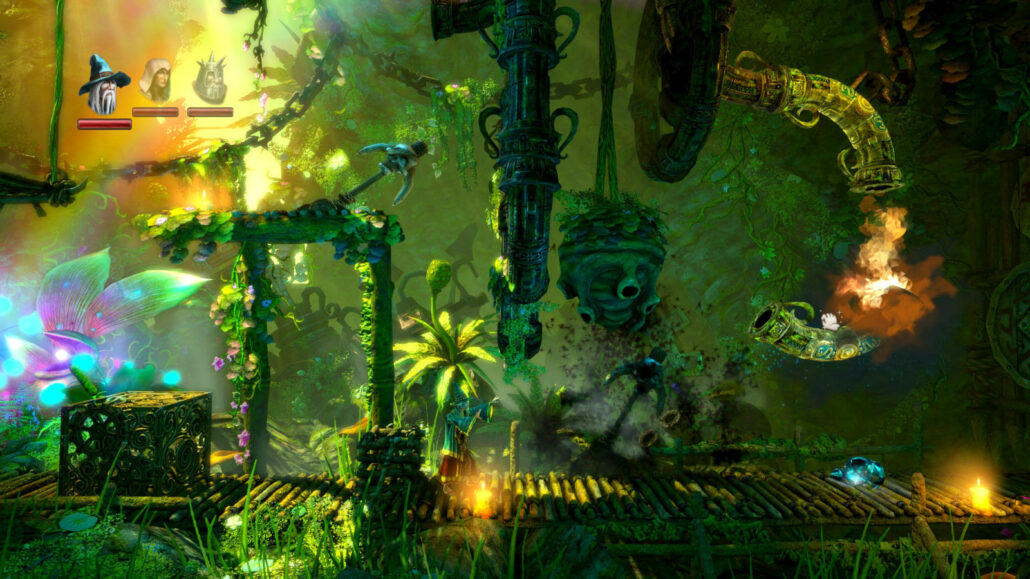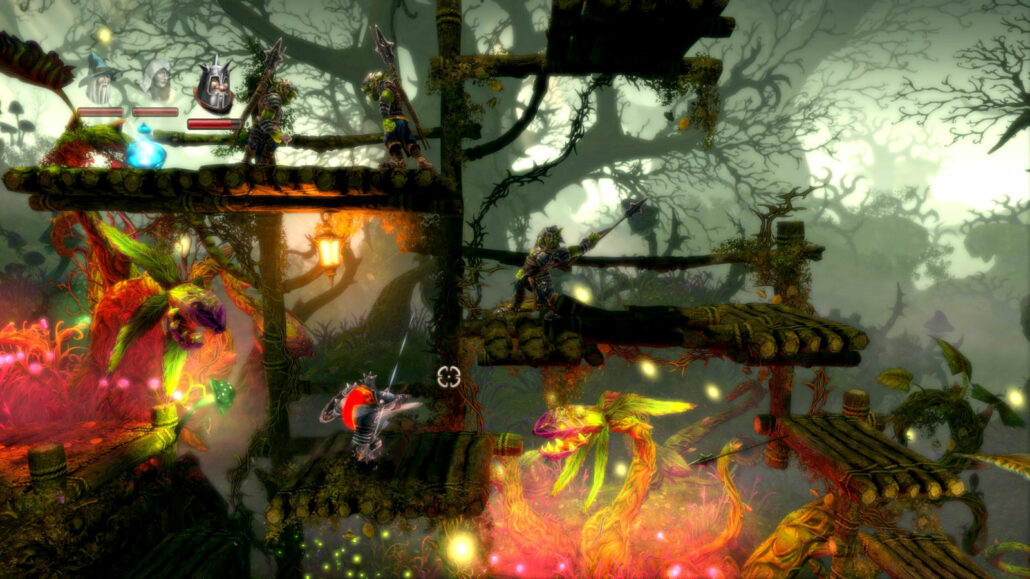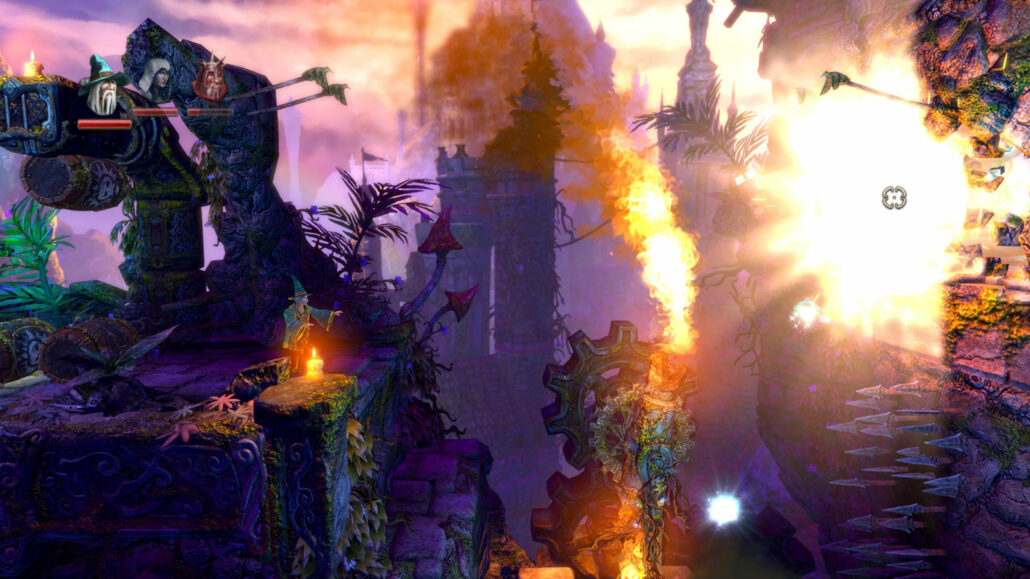Developer: Frozenbyte | Released: 2011 | Genre: Platform, Puzzle
I started this sequel shortly after adding a diary blog post about the first Trine, which I completed back in 2012. That was of course the reason I transferred that, so I could refer back to that blog post.
The sequel was basically more of the same, with only a few tweaks. It had the same trio that I could freely switch between – the wizard Amadeus, the knight Pontius, and the thief Zoya.

Again the wizard could conjure metallic crates out of thin air and also levitate the things the developers allowed me to move. The knight could smash through certain barriers, fight with a sword or a hammer, and protect himself with a shield that could have its direction adjusted with the mouse. The thief could shoot arrows with various strengths, and also shoot a grappling hook for swinging to the other side.
And again the graphics was total eyegasm, with lots of exquisitely animating details. It was brighter and more saturated – perhaps too much for some, but I didn’t mind that. It looked great to me.
The wizard could now both levitate certain objects and also rotate them with left/right hotkeys. There were puzzles with air blown out of pipes where I could levitate a bent piece of pipe, rotate it to fit properly, then attach it to blow wind in another direction. This could then lift a character upwards. This was a cute idea that made good use of the levitation ability. Later the pipes could also be used for fire.
Even better, the wizard no longer needed mana to levitate or conjure crates and planks. A nice boost. The knight was nerfed, however. He could no longer pick up and throw objects, but I didn’t really miss it either. To make up for it, he was more useful fighting goblins since combat was now faster. Speaking of combat, why couldn’t the wizard shoot magic? Being able to throw a fireball would have been logical.

I read in a review of this game that although the wizard couldn’t levitate the crate he was standing on, he could levitate the second one further down and thus reach almost all ledges. That didn’t work when I tried it. The stacked crates just shook a little and that was it. I have a sneaky feeling the developers read that and decided to nerf it in a later patch. Maybe it would have been too much of a “cheat” anyway.
Supposedly the game should have the ability to save anywhere, but that wasn’t quite true. Not exactly the quicksave kind, at least. Dying still threw me back to a checkpoint. While that was a slight disappointment, there were healing bubbles to be found regularly, and going back a few meters to revisit one of these restored the health of all characters and also revived anyone that might have died.
The various levels had their end bosses – typically enormous monsters such as a big snake or a bulky goblin with a big ass club. There were also sometimes big animals that helped me across, such as a snail and a frog, both as big as a house. And both had to be tricked with food.
The platforming and the puzzles were often more of the same as in the first game. In fact, sometimes it almost felt like copy and paste. Falling platforms, spike traps, fire pipes, bouncy fungus, bubbles to lift you slowly upwards, water to dive deep into, that kind of stuff. The skill upgrade screen was also quite familiar and had even more skills now. I quickly bought crate upgrades for the wizard so I could stack more.

Towards the middle of the game, more original puzzles did emerge. Apart from leading water to plants for growing leaves to jump on, portals could be moved around and then have objects thrown through them for popping out of another portal. I also had to deal with carnivorous plants that could eat any character in one bite. I bought the stealth ability for the thief so I had an easier time bypassing those.
Finally, something the thief could do. Why not add some puzzles for her grappling hook?
I used mouse and keyboard, but no doubt the game was made with a gamepad in mind. Especially levers were problematic. I had to hold down a direction, i.e. A or D, while holding down the use key E. Take a look at your keyboard and imagine having to do that. That being said, the sequel was still great at making use of the mouse – for example when a crate had to be conjured by drawing it in the air.
Some of the jump puzzles were downright sadistic in the second half of the game. Just like in the first game, it felt like I was missing just the final quarter of a pixel to reach the ledge on the other side. Swaying beams of fire, dropping platforms and other dynamic stuff spiced it up further. It could be smooth sailing for several screens and then, there it was – a hindrance making me busy for way too long.

After having endured several frustrating spots like that, I finally hit one that seemed downright impossible. It was the one with two rotating fire tubes and a tall wall I blew a hole in. I just couldn’t for the life of me get across that one. So I started looking for cheats on the internet.
Luckily, the developers had cheat mode built into the game. No need for trainers here. All I had to do was edit a configuration file, and then the F6 key made a character jump in the middle of the air. I had to be careful not to spam it or I would be stuck inside the ceiling, but with a relaxed rhythm I could pass the most sinister jump puzzles and actually see the ending of this game.
If on Windows, open File Explorer and type %appdata% in the address field to enter a folder with settings. It should automatically open in the Roaming subfolder. Now enter the Trine 2 folder and edit options.txt in there in e.g. Notepad.
Search for “cheat” and you should find the following line:
setOption(gameBaseApplicationModule, "CheatsEnabled", false)
Change false to true and save the file.
The next time you start the game, you can use the F6 key as described above. Supposedly the F7 key should be full health and F10 invincibility, but they didn’t work for me. Maybe F5 for no clip mode works, I never tried that one.
In one of the final levels of the game, a big snake-like monster was grabbing walls and platforms with its tentacles. It had one eye and it started slapping me downwards in some places. I quickly learned that I just had to hit its eye to make it retract. While it made a lot of sense and worked as intended, I did frown a bit when I tried going invisible with the stealth mode of my thief. The monster completely ignored that. 🤨
Pros
- The graphics and lighting are marvelous to behold, with lots of details going on.
- Animations are smooth and lovely, and there are a few enormous animals to be seen.
- Nice medieval music both on the title screen and also while playing.
- Levitation puzzles where certain objects have to be rotated and then attached to something.
- Healing bubbles makes things easier, at least on the easy difficulty level.
- The mouse is still great for conjuring items by drawing them in the air.
Cons
- Exit to title screen uses save anywhere, but while playing it’s still using checkpoints.
- The story about two sisters is weak – it’s barely there to explain the journey.
- The keyboard controls are quite awkward when handling the biggest type of levers.
- The second half of the game coughs up a few really frustrating jump puzzles.
- Almost devoid of grappling hook puzzles for the thief.



